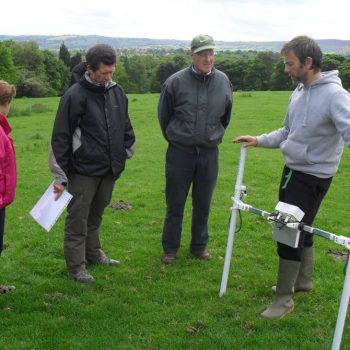All Categories
Featured
Table of Contents
Archaeological Geophysics And Geochemistry - Lgs in Shenton Park WA 2020
Much of the image consists of blank locations now with little or no radar reaction. The "courtyard" wall is still showing highly, however, and there are continuing recommendations of a hard surface in the SE corner. Time piece from 23 to 25ns. This last piece is now nearly all blank, but a few of the walls are still revealing strongly.
How deep are these pieces? The software I have access to makes estimating the depth a little challenging. If, nevertheless, the top three slices represent the ploughsoil, which is most likely about 30cm think, I would think that each piece is about 10cm and we are just coming down about 80cm in overall.

Fortunately for us, the majority of the sites we have an interest in lie just below the plough zone, so it'll do! How does this compare to the other methods? Contrast of the Earth Resistance data (leading left), the magnetometry (bottom left), the 1517ns time slice (top right) and the 1921ns time piece (bottom left).
Geophysical Surveys In Portland, Or in Henley Brook Aus 2023
Magnetometry, as gone over above, is a passive strategy determining local variations in magnetism against a localised absolutely no value. Magnetic susceptibility study is an active method: it is a measure of how magnetic a sample of sediment might be in the presence of an electromagnetic field. How much soil is checked depends upon the size of the test coil: it can be really little or it can be fairly large.
The sensing unit in this case is extremely little and samples a small sample of soil. The Bartington magnetic susceptibility meter with a large "field coil" in use at Verulamium during the course in 2013. Leading soil will be magnetically boosted compared to subsoils just due to natural oxidation and decrease.
By determining magnetic vulnerability at a reasonably coarse scale, we can identify areas of human profession and middens. We do not have access to a trustworthy mag sus meter, but Jarrod Burks (who assisted teach at the course in 2013) has some excellent examples. One of which is the Wildcat website in Ohio.
(Pdf) An Assessment Of Geophysical Survey Techniques ... in Madeley WA 2021
These towns are frequently laid out around a main open area or plaza, such as this rebuilt example at Sunwatch, Dayton, Ohio. Sunwatch Town, Dayton, Ohio (photo: Jarrod Burks). At the Wildcat site, the magnetometer survey had actually found a range of functions and houses. The magnetic susceptibility survey assisted, nevertheless, define the main location of occupation and midden which surrounded the more open location.
Jarrod Burks' magnetic vulnerability study results from the Wildcat website, Ohio. Red is high, blue is low. The technique is therefore of fantastic usage in defining areas of basic profession rather than identifying particular functions.
Geophysical surveying is an applied branch of geophysics, which uses seismic, gravitational, magnetic, electrical and electromagnetic physical methods at the Earth's surface to determine the physical homes of the subsurface - Geophysical Survey - Plaza Of The Columns Complex in Belmont Oz 2023. Geophysical surveying approaches usually determine these geophysical residential or commercial properties together with anomalies in order to evaluate various subsurface conditions such as the presence of groundwater, bedrock, minerals, oil and gas, geothermal resources, voids and cavities, and far more.
Latest Posts
How To Become A Geophysicist in Dalkeith WA 2022
What Is The Best Degree Path For Becoming A Geophysicist? in Floreat WA 2023
Marine Geology And Geophysics in Rivervale Western Australia 2022